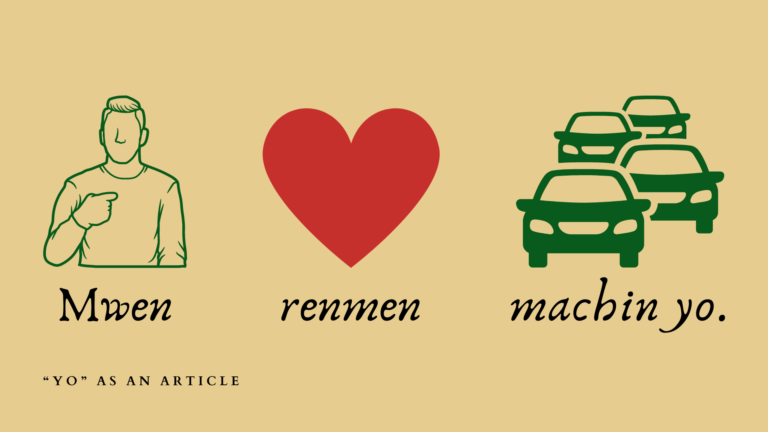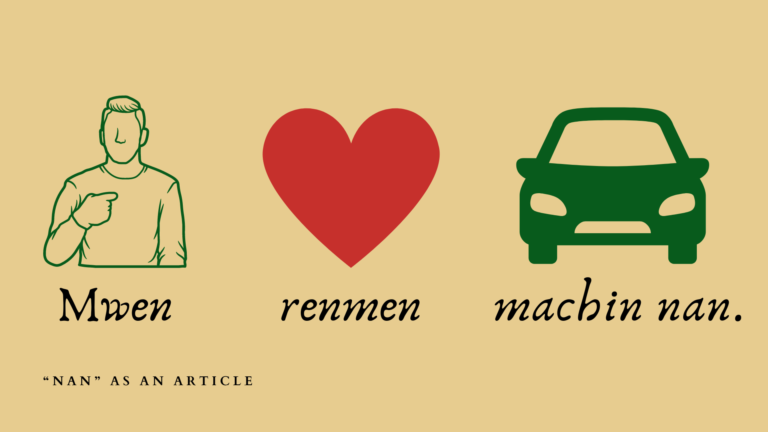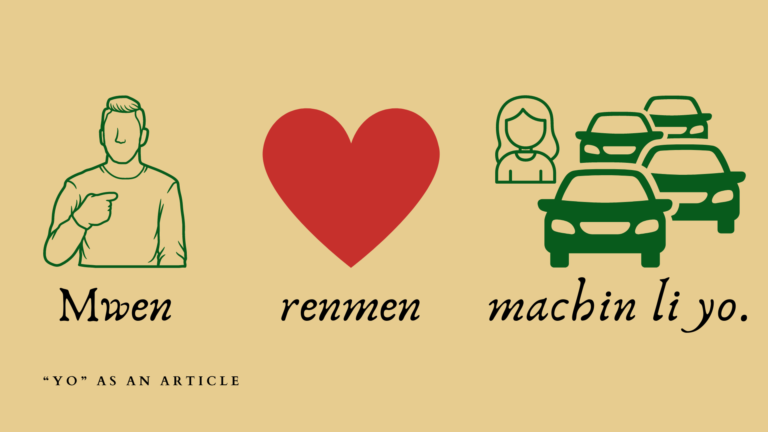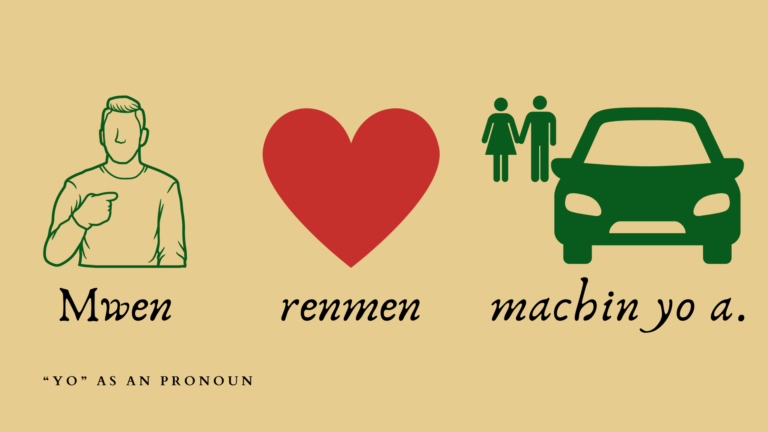Yon, A, La, An, Lan, Nan, & Yo
What is "yo"
We’ve already discussed
- nouns and noun phrases
- the difference between indefinite and definite articles
- the importance of using Haitian Creole definite articles
- “a”
- “la”
- “an”
- “lan”
- “nan”
- When do you use “yo”?
As we come to the last definite article, you may have this question in mind: doesn’t “yo” mean “they”, “them”, and “their”?
You’re absolutely correct: “yo” can be a pronoun.
- Yo renmen timoun. They love children.
- Mwen renmen yo. I love them.
- Pitit yo bèl. Their child is beautiful.
Those are some examples of correct sentences.
Is there another way of using “yo”?
If you said, “Yes, as a plural noun”, then you are correct. “Yo” is also used when there’s more than one person, place or thing in a sentence. For example,
- Mwen renmen machin yo. I love the cars.
- Mwen renmen timoun yo. l love the children.
- Mwen renmen lekòl yo. I love the schools.
Did you know that when using “yo” in this way, you’re actually using a definite article? Cool right? So when “yo” is used as a plural noun, it’s a definite article.
When “yo” is used as a plural noun, it’s a definite article
Here’s a quick question to ask yourself: can “yo” be replaced by another definite article?
If the answer’s yes, then that “yo” is a definite article. For instance,
- Mwen renmen machin yo. I love the cars. — Mwen renmen machin nan. I love the car.
- Mwen renmen timoun yo. I love the children. — Mwen renmen timoun nan. l love the child.
- Mwen renmen lekòl yo. I love the schools. — Mwen renmen lekòl la. I love the school.




Why can it be confusing using “yo”?
It can be challenging to recall all the various ways to use “yo.” For instance, in English, making a noun plural can be as straightforward as adding -s or -es to the end. However, in Creole, it’s essential to remember an entirely different word, “yo.”
- machin yo (cars)
- timoun yo (children)
- lekòl yo (schools)
- mouch yo (flies)
Also, since “yo” can mean so many different things, you may forget to add one at the end of a noun or noun phrase.
For example, how would you translate this sentence:
- They love his cars.
Some learners may say, “yo renmen machin li.” But is this the correct translation? What’s missing?
- Yo
- Yo renmen machin li yo.
Lastly, it may be confusing to identify which meaning of “yo” is being used. Here’s an example:
- Ou wè machin li yo? Yo renmen yo paske yo bèl.
How would you translate that sentence? The correct translation is
- You see his cars? They love them because they are beautiful.
Keep these 3 points in mind as you’re studying the word “yo”.
- Why do you need to know that “yo” is also a definite article?
When it’s the pronoun “their”, a definite article can be used after “yo” at the end of a noun phrase. Which definite article should be used after “yo”?
a
For instance, “machin yo a” (pronounced yo-w-a). Check out our Audio Soundboard in Lesson 20 to hear how to properly pronounce “yo a”.
- Yve: Èske w wè machin yo? Do you see their car?
- Eunice: Wi. Machin yo a la. Yes. Their car is here.
Remember this rule:
don’t say “… yo yo”
For example, you can’t say, “Machin yo yo la” (meaning “their cars are here”). The correct sentence is “machin yo la.”
- What two “yo” sentence structures should you memorize?
1. "yo" as a definite article
Use this when using “yo” as a definite article. In other words, a plural noun.
- gason
- fi
- chat
- chen
- kay
- machin
- pitit
- timoun
- granmoun
- frè
- sè
- mwen / m
- ou / w
- li / l
- nou / n
- use as a plural noun
- can also be replaced by other definite articles
- a
- la
- an
- lan
- nan
Machin mwen yo bèl. My cars are beautiful.
Machin li yo bèl. His cars are beautiful.
Kay mwen yo bèl. My houses are beautiful.
Kay li yo bèl. Her houses are beautiful.
Lekòl mwen yo bèl. My schools are beautiful.
Lekòl li yo bèl. His schools are beautiful.
2. "yo" as a pronoun
Use this when using “yo” as the pronoun “their”.
- gason
- fi
- chat
- chen
- kay
- machin
- pitit
- timoun
- granmoun
- use for “their”
- the definite article “a”
- this doesn’t change
Machin yo a bèl. Their car is beautiful.
Kay yo a bèl. Their house is beautiful.
Lekòl yo a bèl. Their school is beautiful.
Practice
Dekri foto ou wè anba yo. Eseye fè tèt ou travay lè w poze yon seri kesyon tankou: ‘ki sa, poukisa, ki lè, ki kote, kiyès, e ki jan’. Fè efò pou w sèvi ak “yo” anpil. (click the pictures to enlarge)



